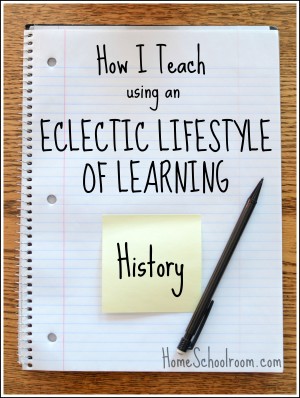How I Teach History Using an Eclectic Lifestyle of Learning

Remember when I said that before I started homeschooling I was excited to share my love of science with my children? Well…I didn’t have the same enthusiasm for history. It was never my favorite subject in school–it seemed just lists of dates and names that I could not remember.
The History of Our Homeschool History Studies
Our first attempt at history was studying the Revolutionary War using a free Homeschool Share unit. We read wonderful stories of the people and events, watched dramatizations of the action, and made period food and crafts. No one had ever told me history was so interesting!
We continued immersing ourselves in historical time periods over the next two years. It was still fascinating, but I found the need to simplify this year. I was planning too much, creating an overwhelming workload for myself and listing more work than we could ever complete. It was taking away the joy of our learning, and kept us from moving on and learning new information because I was waiting to complete all the things I had planned!
So this year, it’s a less-is-more approach. I’ve made great strides in taming my tendency to plan too much. It’s not to say we’re less interested or even that we’re learning less, but I’m planning less, we’re focused more on reading and narrating, with hands-on activities directed by my children with less work from me.
Not only is this more relaxing and joyful for me, but we’re moving through the periods at a reasonable speed, staying in tune with prime interest and learning and allowing them to see the connections between time periods!
Homeschooling History Take Two: Relaxed, Eclectic
I’m using Story of the World as our spine along with the corresponding activity guide. So far we haven’t used many of the activity suggestions, but I use the book lists for extra reading and usually one of the maps for each civilization. Using a spine text has simplified my planning. The other must-have resource for me is All Through The Ages, a guide full of recommended living books to use in studying history.
Here’s our simple plan for history studies:
- FOCUS ON READING:
- We read a chapter in Story of the World for a basic understanding of events.
- We read living literature to give us a deeper understanding. And read…and read some more!
- We watch videos for fun and educational value. This can be anything from the hilarious Horrible Histories to documentaries on Netflix.
- NARRATE:
- My children narrate what they have gleaned from our reading. (More details on our narration in just a minute.)
- If time and ideas permit WE MAKE AND DO. (I’ll talk more about how and what…just keep reading!)
A Note on Narrating
Narrating is simply retelling what the child has learned in their own words. It’s a simple yet powerful Charlotte Mason technique. The difference this year is how often I’m having my children narrate and how I’ve simplified the implementation. We’re narrating nearly all of our history reading, so it is happening at least a couple times a week. Recording them is simple: my daughter writes or types her own (we edit together when she’s done) and my son draws a picture then gives me an oral narration while I act as his scribe. No searching for themed notebook pages or fussy to cut minibooks. Just plain printer or notebook paper, filled with ideas bursting from their minds!
Our Hands-On History Learning
Our simplified plan doesn’t mean no hands-on learning opportunities. I’m just more careful about which ones and how much it requires of me. I’m not combing the internet and trying to orchestrate every hands-on learning opportunity I see. I keep a tight reign on what activities I plan, keeping in mind what can be learned or reinforced by it, and how much time and effort it requires, both from me and my children.
What has worked well so far is a two pronged approach that facilitates hands-on learning without bringing back my overworked feelings:
- For each civilization one of the books I choose is one with activities: games, crafts, recipes, etc. For instance, we used the book Ancient Egyptians and Their Neighbors when studying Ancient Egypt. I can choose hands-on ideas, or my daughter (who loves making things) can choose independent projects.
- I allow my children’s ideas, and what intrigues them from the information, be my guide. For example, it is common for my children to role-play our history studies. One day they decided, on their own, to act out one of the Greek myths. Now I’m happy to help them make simple Greek costumes from a white sheet (from the book Spend the Day in Ancient Greece). I am confident a little effort on my part will enhance their reenacting, and this will in turn help them remember the stories even better.
That’s the how-to of our history studies. There’s one more installment in the “How I Teach” series. Join me next time when I put on the finishing touches: fine arts!
The “How I Teach” Series:
 Hi, I'm Heidi and I homeschool my two sweet kids. I want them to know that learning is an exciting lifelong adventure! We love great books, unit studies, notebooking, lapbooking, and hands-on learning.
Hi, I'm Heidi and I homeschool my two sweet kids. I want them to know that learning is an exciting lifelong adventure! We love great books, unit studies, notebooking, lapbooking, and hands-on learning.



